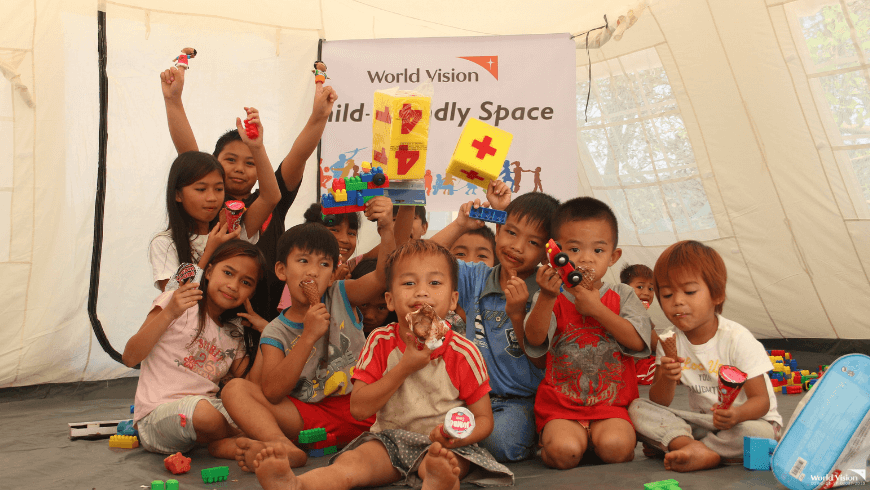Disaster Response
Responding to Disasters

World Vision believes that children deserve to live in safe and disaster-resilient communities where they can play, grow and thrive. To help achieve this, we encourage children, families, schools, and communities to proactively get involved in activities that will make their communities prepared for disasters and emergencies. In 2018, World Vision trained 16,810 community members, including children, on disaster risk preparedness measures, and 14,463 community members, including children, on disaster prevention and mitigation. Our disaster risk reduction initiatives reached a total of 189,099 children in the past year.
When disasters strike and impending humanitarian needs arise, World Vision is also prepared to respond and provide immediate life-saving essentials. World Vision prepositioned hygiene kits, and shelter and non-food items to facilitate quick response to affected areas.
Mayon Volcano Response
More than 21,000 families or 83,000 individuals were forced to flee to evacuation centers after Mayon Volcano discharged ash and lava on January 2018. To complement the government-led response, World Vision distributed hygiene kits, non-food items, facemasks, and drinking water to 2,000 families or 10,328 individuals in Albay.
Typhoon Mangkhut Response
Locally known as “Ompong,” Typhoon Mangkhut struck Northern Philippines on September 2018, affecting more than 3 million individuals and damaging more than 210,000 households. With the help of donors and partners, World Vision provided relief assistance to 4,082 families or 20,455 individuals in Cagayan and Benguet. We also set up child-friendly spaces to give psychosocial support to children whose lives and education were disrupted by the disaster. Now on its recovery phase, World Vision’s Typhoon Mangkhut response aims to help families bounce back from their losses through agricultural recovery assistance.
Marawi Rehabilitation
One year after the Marawi conflict displaced more than 350,000 individuals, World Vision continues to support community rehabilitation through its Cash-for-Work program. Marawi’s early recovery and rehabilitation phase allowed more than 3,000 families to join community clean ups, road clearings, and gardening activities, and earn cash in return. In 2018, we also launched the Marawi Peace and Protection Project in support of DepEd’s Back-to-School and Stay-in-School (BTS/SIS) strategy for Marawi children.
THE JOY OF BEING HEARD
To help communities be better prepared in any disaster, World Vision provides platforms where children and the youth can be actively involved in issues and conversations about disaster-risk reduction. Angela, a Sangguniang Kabataan (SK) councilor from Quezon City, is one of the 57 children who participated in the National Consultation with Children and Youth on Disaster Risk Reduction from May 31 to June 1, 2018. The consultation encouraged children to discuss the important role of Filipino youth in mitigating disasters and promoting resilience. “I feel very proud and empowered because children and youth were able to show how massive our potential is to be contributors to greater causes such as Disaster Risk Reduction,” Angela shared. “We are finally speaking our voices and we’re finally gaining more trust from the government.”
How do we help communities affected by disasters?
In the middle of a crisis, it is children who suffer most. We stand ready to protect them by delivering crucial assistance within 24 to 72 hours of a disaster.
We make sure that communities have the proper measures to prevent, reduce and prepare for the impacts of disasters.

We teach child-focused Disaster Risk Reduction Management in communities and schools

We support the identification and establishment of functional Early Warning Systems in communities

We strengthen the capacity of community members to prevent, lessen and prepare for the negative impacts of disasters
We increase resilience against disasters
Child-Focused Disaster Risk Reduction engages communities, including children and other vulnerable members of society, in disaster risk assessment, analysis, and planning.
Safer School facilitates the creation of School Improvement Plans aimed to make schools safer. We make sure that children join us in these processes to ensure that their rights are valued and considered.
Citizen’s Voice in Action empowers community members to work with local officials in making development plans and policies before and after disasters.
Urban Disaster Risk Reduction covers initiatives to mitigate and recover from urban shocks by mobilizing communities, partners, and volunteers and increasing their capacities on vulnerability assessment, DRR planning and implementation.



